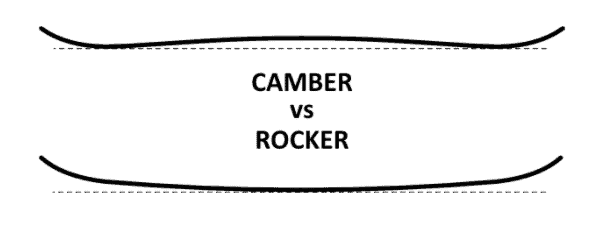When snowboards were first invented they came in all different shapes and sizes. Then in the 1980s, camber was introduced and that became standard for all future designs.
However, the 2000s saw a re-emergence of alternative snowboard design and today snowboarding profiles have many variations.
In this article I explain all the different snowboard profiles and outline how they can your snowboarding style.

Disclaimer: Some links in this article are affiliate links, which means that if you purchase through them I receive a small commission, at no extra cost to you. This helps cover the cost of running this blog. Thanks for your support!
| Camber refers to the convex bend in a snowboard profile, whereas rocker refers to the concave bend in a snowboard profile. Camber boards are typically good for free-riding and carving whereas rocker boards are good for riding powder, buttering and pressing. Rocker-style boards are typically recommended for complete beginners as they are easier to turn and less likely to catch an edge. |
Snowboard Terminology
Before we dive into the world of snowboarding camber profiles, first let’s get familiar with the terminology used in the snowboarding world.
- Snowboard profile – when placed flat on the ground, looking at the snowboard from the side is known as the snowboard profile.
- Tip or nose is the front of a snowboard.
- Tail is the back of the snowboard.
- A contact point is the area of a snowboard that comes into contact with the snow when you stand on the board.
What is Camber on a Snowboard?
Camber refers to the arch underneath the snowboard. This convex shape provides the snowboard profile to that of a bridge. This is also known as traditional camber since this was the norm for several decades.
With Traditional camber the arch runs from the contact point at the nose of the snowboard to the contact point at the tail of the snowboard.

Benefits of camber on a snowboard
- Great pop for ollies (jumps) since the board is already pre-tensioned. (When you shift weight onto the tail, the board wants to pop back much liked a coiled spring).
- Perfect for carving and holding an edge at speed since more of the effective edge is in contact with the snow.
- More stable at speed and great when combined with a stiff snowboard boot
Downsides of a camber on a snowboard
- Easy to catch an edge
- Doesn’t have the best float in powder
- Less manoeuvrable at slow speed
What is Rocker/reverse Camber on a Snowboard?
Rocker refers to the concave bend in a snowboard which gives it a profile similar to a banana. Rocker is also known as reverse camber or negative camber.

Benefits of reverse camber on a snowboard
- The raised tip and concave shape provides natural float in powder.
- With less effective edge turn initiation is easier which makes it easier for beginners.
- Easier to manoeuvre at slow speeds and great paired with softer flex snowboard bindings.
- Great for buttering and pressing making it popular with jibbers and rail riders.
Downsides of reverse camber on a snowboard
- Doesn’t hold an edge as well so are harder to carve
- Are prone to washing out turns
- Less pop
- Twitchy at speed
What About Flat Snowboards?
Flat boards, also known as zero rocker or zero camber don’t have any bend in the profile of the board.

Since the flat board sits somewhere between a camber and a rocker profile, so do the pros and cons. A flat board is more stable than a rocker board but more prone to catching an edge. With so much of the edge in contact with the snow it’s slower than a camber board but is quicker from edge to edge.
Learn about the useful edge of a snowboard in this guide about snowboard sidecuts.
Hybrid Snowboards
Recognising that riders may want the benefits of all types of snowboard profiles, many hybrid designs now exist. These boards aim to provide the best of both worlds by mixing camber, flat and rocker.
Hybrid Camber – Rocker/Camber/Rocker
This type of hybrid keeps the camber between the feet to ensure stability and pop. However the rocker on tip and tail provides better float in powder and allows for easier turn initiation.
Within this hybrid design there are further differences between designs. For example, the length and prominence of camber and rocker sections. Those designs favouring longer and more prominent camber will produce a ride more similar to a traditional camber board, whereas the design with longer and more prominent rockers with produce a ride more similar to a traditional rocker board.
As someone who likes to ride all types of terrain, this is my preferred board of choice. I got my first hybrid board in 2010 and have stuck with them ever since. This is a popular choice for split boards.

Directional hybrid camber
With a directional hybrid camber, the camber extends more towards the tail with the rocker extending longer from the nose. This type of snowboard profile works best in powder and at high speed. This will often be paired with directional sidecut to allow explosion out of turns. The directionality of this board makes it difficult to ride switch.

Hybrid Rocker – Camber/Rocker/Camber
The rocker between the feet allows for more manoeuvrability and better float in powder, whilst the camber under feet produces the pop you might expect from a camber board. Not as stable as a hybrid camber but with the playfulness of a rocker.

Camber vs Rocker as a Beginner
Before you decide which snowboard profile to choose as a beginner you might like to think about how much time you will dedicate to riding.
If you’re likely to only get a one-week holiday each season, a rocker or hybrid rocker board will be more forgiving and may ultimately be a more enjoyable ride. If you’re getting ready for your first season where you’ll be able to ride most days, a camber or hybrid camber board will allow for the big progression you’re likely to see.
As your snowboarding progresses and changes, so will your preference for a particular snowboard profile. Many hills offer demo days where you can try out new boards, so don’t be afraid to test out different types before you make your next purchase.
Related Reading
- What snowboard binding angles should I use?
- How to setup your snowboard
- What is Magne Traction and why do I need it?
- Snowboard boot lacing systems
Snowboard Camber vs Rocker Summary
Both camber boards and rocker boards have their own pros and cons. Typically camber boards are better for carving, popping and are more stable at speed. Rocker boards are easier to turn, butter and provide better float in powder. Hybrid boards aim to provide the best of both worlds whilst typically favouring one type over the other.
Before you decide which board is right for you, decide what type of riding you prefer. If you prefer charging down groomed runs or hitting big jumps you will benefit from a more camber biased board. If you prefer surfing powder and jibbing you will benefit more from a rocker biased board.
